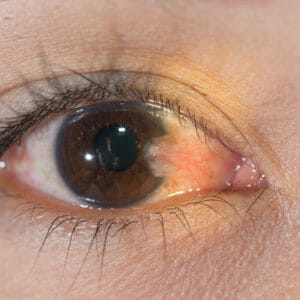 Our doctors are trusted providers of pterygium treatment in Northern Nevada, with experience in numerous surgical procedures, including conjunctival grafts, amniotic membrane grafts, and tissue glue.
Our doctors are trusted providers of pterygium treatment in Northern Nevada, with experience in numerous surgical procedures, including conjunctival grafts, amniotic membrane grafts, and tissue glue.
What is a pterygium?
A pterygium is a growth on the surface of the eye. It typically appears as an elevated area on the white part of the eye (the conjunctiva), and is often red due to blood vessels. As the pterygium grows onto the cornea, it becomes noticeable in the “colored part of the eye.” While the cause is not clear, pterygium is most commonly seen in people who have had significant exposure to the sun and wind during their lifetime.
What are the symptoms of pterygium?
In many cases, pterygium is asymptomatic, and the patient perceives no problem. In other cases, the pterygium can get inflamed, resulting in redness, irritation, burning, and tearing. And if the pterygium grows larger, it may result in increased astigmatism and reduced vision.
How is pterygium treated?
The best treatment is prevention. It is always recommended that sunglasses be worn outside during the day to reduce exposure to ultraviolet light. Over-the-counter artificial tears are recommended as needed to prevent or reduce inflammation. In cases of severe inflammation, anti-inflammatory eye drops may be prescribed. Surgical pterygium excision may be recommended when 1) chronic inflammation does not respond to topical treatment, 2) the pterygium continues to grow, or 3) the pterygium is large enough to adversely affect vision.
What is involved in pterygium surgery?
Pterygium surgery has evolved over the years, and there are a number of different approaches. Years ago, pterygium was simply taken off the eye in the office without further treatment; in up to 50% of those cases, the pterygium would grow right back. Nowadays, pterygium surgery is performed as an outpatient procedure in the operating room, under intravenous sedation (not general anesthesia). In most cases, a graft is placed after the pterygium is removed; the graft is either amniotic membrane (derived from placental tissue), or conjunctiva obtained. In most cases, sutures are not required.
What happens after pterygium surgery?
A combination of eye drops and ointment are used until the eye is healed. Afterward, it is recommended that artificial tears and sunglasses continue to be used to help prevent regrowth of the pterygium. Vision may be blurry during the first week or longer, and glasses may need to be changed after the eye is healed; it is very uncommon for the vision to get worse after pterygium surgery. It is very important to comply with follow-up visits, especially during the first year after surgery, to monitor for any recurrence of the pterygium.




